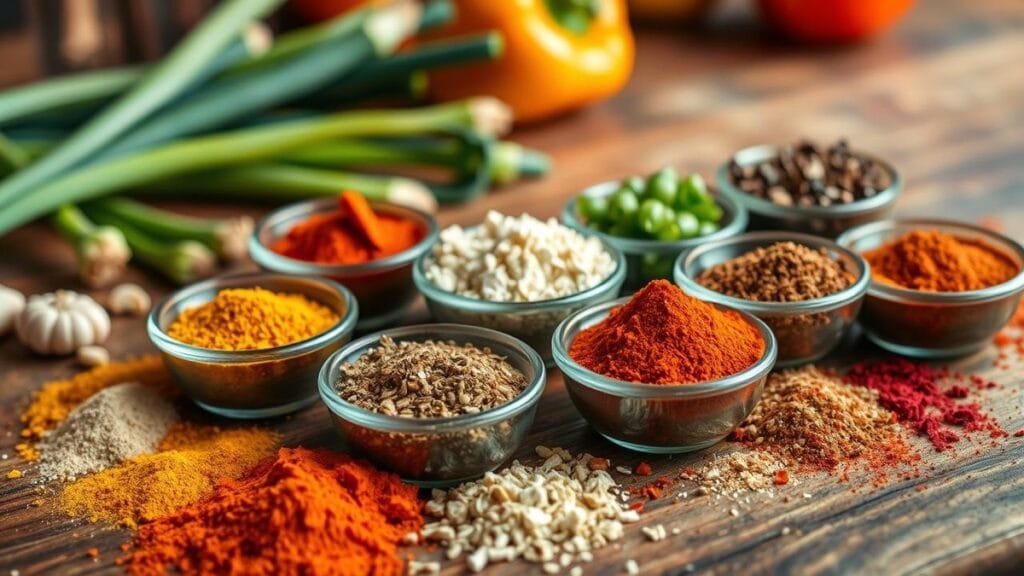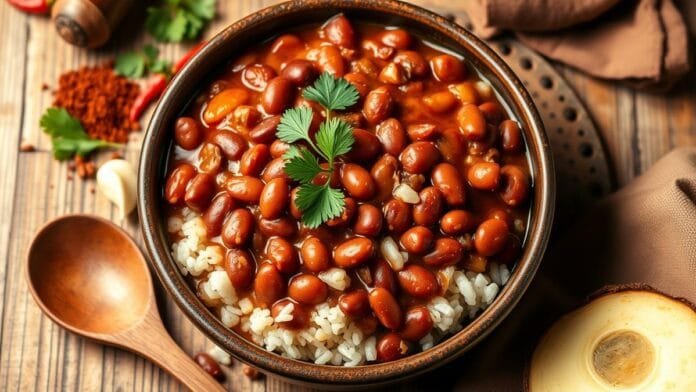I grew up in Louisiana, where food is a big part of our culture. Cajun red beans and rice is a dish that’s close to my heart. It’s a hearty, flavorful dish that’s been enjoyed in Louisiana for years.
When I was young, the smell of red beans cooking would fill our home on Mondays. This was a special day for this classic dish. Soaking the beans, sautéing the veggies, and letting the flavors mix together was a tradition I loved.
Now, I’m excited to share the secrets of making authentic Cajun red beans and rice. This dish is a big part of my heritage. It shows how Cajun cooks turned simple ingredients into a delicious meal.
The Rich History of Louisiana Red Beans and Rice
Red beans and rice is a beloved dish in Louisiana, with roots in the state’s cultural history. It has grown over time, showing the strength and creativity of Cajun and Creole communities. This classic dish is a staple in New Orleans, cherished by many.
The Monday Tradition in New Orleans
In New Orleans, Mondays are for red beans and rice. This tradition goes back generations. It started during the Great Depression as a cheap, filling meal for families.
It was made with leftover ham bones from Sundays. This way, families could enjoy a hearty meal while doing laundry.
Cultural Significance in Cajun Cuisine
Red beans and rice is loved worldwide for its flavor and ability to unite people. It’s a key part of Louisiana’s culinary history. Chefs and home cooks add their own touches, making it modern yet traditional.
Today, it remains a highlight in New Orleans, showing the lasting impact of Cajun soul food.
| Traditional New Orleans Restaurants Serving Red Beans and Rice |
|---|
| Napoleon House |
| Joey K’s |
| Felix’s Restaurant & Oyster Bar |
| Café Reconcile |
| Dooky Chase’s |
| Lil Dizzy’s |
| Coop’s Place |
| Buffa’s |
| Evangeline |
| Mambo’s |
Essential Ingredients for Cajun Red Beans and Rice Recipe
Cajun red beans and rice is a beloved dish from Louisiana. It’s made with a few key ingredients that create the authentic Cajun flavor. Let’s explore the essential elements that make this recipe stand out.
The dish starts with dried red kidney beans. These beans are packed with protein and give the dish its creamy texture. Andouille sausage, a spicy smoked pork sausage, adds a bold, smoky flavor. Bacon and smoked ham also add to the dish’s meaty taste.
The “holy trinity” of Cajun cooking is onions, green bell peppers, and celery. These aromatics create a flavorful base. Minced garlic, dried herbs like oregano and thyme, and Cajun seasoning blend add depth to the taste.
- Dried red kidney beans
- Andouille sausage
- Bacon and smoked ham
- Onions, green bell peppers, and celery (the “holy trinity”)
- Garlic, dried oregano, thyme, and Cajun seasoning
- Chicken or vegetable stock
- Long grain white rice
To serve, the simmered beans are ladled over fluffy, steaming hot long grain white rice. This creates a perfect balance of flavors and textures. The dish’s robust and satisfying taste comes from the smoked meats, aromatic vegetables, and seasonings.
| Cuisine | Primary Cooking Method | Dietary Info | Skill Level | Rating |
|---|---|---|---|---|
| Cajun and Creole | Simmering | Gluten-Free, Dairy-Free | Beginner-friendly | 4.75 from 51 votes |

Preparation and Bean Soaking Methods
Soaking dried beans is key in making a true Cajun red bean recipe. It makes digestion easier and cooking faster. There are two main ways to soak red beans: the overnight soak and the quick-soak method.
Overnight Soaking Technique
The overnight soak method is simple. Just cover the red beans with twice their volume in water. Let them soak for 12 hours or overnight. This way, the beans stay in shape better and cook more evenly, making the dish creamier.
Quick-Soak Alternative Method
If you’re in a hurry, try the quick-soak method. Boil the red beans and water, then turn off the heat. Let them soak for 1-4 hours. This method is quicker but can also work well when time is tight.
Why Proper Soaking Matters
Soaking beans right is vital for the authentic taste and texture of Cajun red beans and rice. Soaked beans are softer, keep their shape better, and make the dish creamier. Soaking also cuts down on sugars that can upset your stomach, making the beans easier to digest. After soaking, drain and rinse the beans to get rid of any dirt.
Knowing and using the right soaking methods helps home cooks make their red bean recipe just like the classic Cajun dish. This dish is a favorite in Louisiana.
Step-by-Step Cooking Instructions
Making the perfect cajun red beans and rice recipe is a journey worth taking. It results in a dish that’s both comforting and full of flavor. This dish truly captures the heart of southern cooking. Follow these steps to make this Louisiana classic in your kitchen.
- Start by cooking chopped bacon in a big pot until it’s crispy. Keep the fat in the pot.
- Then, cook the Andouille sausage in the bacon fat. This lets the flavors mix well.
- After the sausage is browned, cook the “holy trinity” – onions, bell peppers, and celery – in the fat. They should be soft and fragrant.
- Add soaked red beans, chicken stock, meats, and Cajun seasonings to the pot. Let it boil, then simmer for 2 hours. Stir now and then until the beans are soft and the liquid has thickened.
- Just before finishing, remove the bay leaves. Use a masher or spoon to smash some beans against the pot. This thickens the sauce.
- Just before serving, add fresh parsley or green onions to the cajun red beans and rice. Serve it over fluffy white rice.
Patience is key when making this dish. Let the flavors blend as the beans simmer. Stir occasionally to prevent sticking. With time and care, you’ll get a rich, savory, Cajun red beans and rice dish.
| Ingredient | Amount |
|---|---|
| Dry Red Beans | 1 lb. |
| Andouille Sausage | 14 oz. |
| Yellow Onion | 1 |
| Green Bell Pepper | 1 |
| Celery Ribs | 3 |
| Garlic Cloves | 4 |
Tips for Achieving Authentic Creamy Texture
Authentic Louisiana red beans and rice should be thick and creamy, not watery. To get this right, you need to know a few tricks. These tips will help you make this comforting dish just like it’s from the South.
Proper Cooking Temperature Control
It’s important to simmer the beans gently and consistently. A fast boil can make the beans grainy. Keep the pot at a soft bubble, adjusting the heat to avoid losing too much liquid.
Bean Consistency Testing
Check the beans often to see if they’re creamy. Mash a few against the pot’s side. They should break down easily. If they’re not soft, keep simmering until they are.
Thickening Techniques
If the dish gets too thin, there are ways to thicken it. Let it simmer uncovered to reduce liquid. You can also mash more beans or add a bit of broth. Stirring helps prevent sticking and ensures even cooking.
Remember, the dish will thicken as it cools. Adjust the consistency before it cools down. With practice, you’ll get that creamy texture that makes this dish so loved.
| Metric | Value |
|---|---|
| Social Media Shares | 28,733 |
| Total Time | 7 hours |
| Prep Time | 15 minutes |
| Cook Time | 2 hours 45 minutes |
| Calories per Serving | 514.5 kcal |
| Recipe Rating | 4.77 out of 5 (17 votes) |
| Servings | 8 |
| Total Cooking Time | 3 hours 45 minutes |
| Nutritional Facts per Serving | 542 calories, 21g fat, 63g carbs, 26g protein |
| Total Fat | 26% of daily value |
| Saturated Fat | 32% of daily value |
| Fiber | 36% of daily value, 10g per serving |
| Sodium | 1384mg, 60% of daily value |

Conclusion
Cajun red beans and rice is a beloved dish from Louisiana. It’s made with simple ingredients but tastes rich and hearty. This dish is more than a recipe; it’s a taste of New Orleans tradition.
To make this classic comfort food at home, follow the authentic methods. Use quality ingredients and pay attention to texture. This way, you can recreate this beloved dish.
Serve the cajun red beans and rice recipe with cornbread, collard greens, or fried chicken for a complete Southern meal. It tastes even better the next day as flavors meld. Whether you’re from Louisiana or just love louisiana cuisine, this recipe will become a family favorite.
Learning to make Cajun red beans and rice is rewarding. It connects us to New Orleans’ rich culinary heritage. With patience and attention to detail, you can bring these iconic flavors into your kitchen. It’s like taking a trip to the vibrant streets of the Crescent City.
FAQ
What are the key ingredients in Cajun red beans and rice?
To make authentic Cajun red beans and rice, you need dried red kidney beans, Andouille sausage, bacon, smoked ham, the “holy trinity” of onion, green bell pepper, and celery, as well as garlic. Chicken stock, seasonings like oregano, thyme, bay leaves, black pepper, Cajun seasoning, and long-grain white rice are also essential.
Why is soaking the beans important for this recipe?
Soaking the beans helps with easier digestion and quicker cooking. You can soak them overnight using twice the water as beans for 12 hours or use the quick-soak method, which involves boiling them briefly and then soaking for 1-4 hours. This ensures even cooking and a creamy texture.
What is the traditional Monday cooking tradition in New Orleans?
In New Orleans, red beans and rice are traditionally cooked on Mondays. This stems from the custom of cooking a slow-simmered meal while doing laundry, often using leftover ham bone. It has become a staple of Cajun cuisine.
How do you achieve the authentic thick and creamy texture for Cajun red beans and rice?
To achieve a thick and creamy texture, cook the beans at a gentle simmer until tender. Mash some beans against the pot’s side to help thicken the mixture. You can also cook uncovered to reduce liquid if needed. Add broth if the dish becomes too thick and stir frequently to prevent sticking.
What are some serving suggestions for Cajun red beans and rice?
Serve Cajun red beans and rice with cornbread, collard greens, or fried chicken. The dish often tastes even better the next day, making it ideal for leftovers or meal prep.














